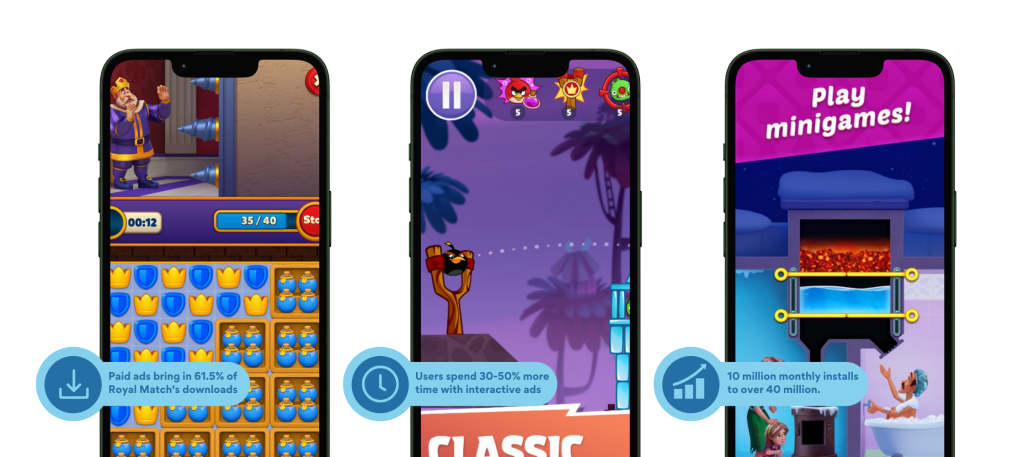Playable Ads Examples That Doubled User Engagement
Picture getting seven times more conversions than your regular ad campaigns. This isn’t a fantasy – playable ads examples have delivered these results consistently, with conversion rates up to 700% higher than traditional formats. These interactive ads stick in people’s minds 32% better than static or video options and hold user attention much longer.
Playable ads are reshaping the scene of digital advertising, and we’ve watched it happen. They bring in $11 to $25 for every 1,000 impressions. The numbers tell an impressive story – engagement rates stay between 15% and 30%, nowhere near what conventional methods achieve. Gaming companies have tripled their in-app purchases, while financial services cut their cost per lead by 66%. These success stories show what playable ads can do.
This detailed guide breaks down the best playable ads examples. You’ll learn about their essential parts and the strategies that helped gaming and non-gaming brands double their user engagement. The guide works for everyone – from interactive advertising newcomers to veterans looking to boost their current campaigns. You’ll learn practical ways to improve your advertising results.
The Anatomy of High-Converting Playable Ads
The success of playable ads depends on understanding their basic structure. Looking at what works reveals patterns that boost user participation and conversions.
Key Components That Drive Engagement

Every successful playable ad combines three vital elements that work together:
- Tutorial prompt: Shows up in the first 2-3 seconds to tell users how to use the ad
- Interactive gameplay: The main experience runs 15-60 seconds while users play actively
- End card: The final screen shows a compelling call-to-action
These elements guide users naturally from start to finish. Playable ads stand out because they respond to user actions instead of just showing content. Users connect better with this hands-on approach, which leads to higher conversion rates.
Tutorial Prompts: First 3 Seconds Matter
Users make snap decisions about content in just 3 seconds. You’ll lose them forever if you don’t grab their attention right away.
Start screens work best with 2-3 Areas of Interest (AOIs). Eye-tracking studies show users are 10x more likely to see everything compared to screens with 4-5 AOIs. Users spend only 1.7 seconds reading start-screen instructions, so keeping them short is key.
Text combined with visual hints gets 1.4x more engagement than just text alone. Moving icons instead of static text can hold attention for about four more seconds.
Interactive Gameplay: The Heart of User Experience
Players need to understand the gameplay right away. Most ads run between 15-60 seconds, but shorter ones lasting 15-20 seconds get 15% better click-through rates.
Smart placement of interactive elements makes a difference. AOIs just above or below the main gameplay area catch 62% of players’ attention naturally. Only 26% notice elements on the sides.
Simple gameplay is the way to go. Players should get value quickly without getting confused. One industry expert puts it well: “Users should instinctively understand how the game operates so they can begin interacting with the ad immediately”.
End Cards That Convert: Call-to-Action Optimization
End cards give you one last shot at making an impression and getting action. Interactive end cards get nine times more viewer engagement than static ones. Campaigns with better end cards see up to 50% more return on investment and spend 20% less per install.
Your end card should have 3-4 Areas of Interest. Players are four times more likely to notice everything with this setup. The main call-to-action belongs in the center – players spot it twice as fast there compared to top or bottom placement.
Keep your end card text short since players only spend 0.7 seconds reading it. Interactive end cards get 47% higher click-through rates than static ones. A clear, direct CTA that pushes for immediate action works best.
These ads work great, but you should test different video and end card combinations to get the best results. The top playable ads keep getting better through careful A/B testing and performance tracking.
Gaming Industry Success Stories: 700% Higher Conversion Rates
The numbers tell a clear story – playable ads are changing how gaming companies get new users, and the results are amazing. Studies show these interactive ads convert up to 700% better than regular video ads. These incredible results explain why big gaming companies now put playable ads at the center of their marketing plans.

Royal Match: From Mini-Game to 22 Million Downloads
Dream Games’ Royal Match shows just how powerful playable ads can be. The puzzle game has made over $3 billion and reached more than 300 million downloads since its 2021 launch. Paid ads bring in 61.5% of Royal Match’s downloads – that’s four times more than Candy Crush’s 15.4%-25%.
Royal Match uses mini-games where players must save King Robert from danger. These ads show real match-3 gameplay instead of misleading content. The strategy works so well because these playable ads blend into the actual game through “King’s Nightmare” episodes. This creates a smooth connection between ads and gameplay.
Players get 50 coins as rewards after beating these mini-game challenges. The whole experience fits together perfectly – what players see in ads matches what they get in the game. This builds trust before they even hit the download button.
Angry Birds: How Rovio Got 30% More High-Value Users
We don’t have much specific data about Angry Birds, but industry numbers show why Rovio’s playable ads worked so well. Games that use playable ads see about 20% better 7-day retention rates compared to other marketing methods.
Playable ads give Angry Birds players a free demo that makes them more likely to download. Users spend 30-50% more time with these interactive ads. This suggests they feel more connected to the gameplay before installing.
These ads work because they filter out uninterested users and attract people who really like the core gameplay. New players who come through playable ads are more likely to spend money in the game after installing.
Homescapes: Playable Puzzle Strategy That Cut Costs by 40%
Playrix’s Homescapes proves playable ads can boost engagement and save money at the same time. The game uses “endless loop playables” – simple, repeating gameplay that shows core features like room decoration.
Playrix first got criticism for using “fake” gameplay in ads. The company then took a bold step by adding these advertised experiences into their games. This move worked in two ways: players got the gameplay they expected, and teams could improve both ads and game features based on what worked best.
This teamwork between marketing and development helped Playrix games jump from 10 million monthly installs to over 40 million. The strategy let Homescapes find which playable ad elements worked best and optimize their Cost Per Install.
Yes, it is clear that adding playable ads to marketing plans gets great results in gaming. Research shows users who download after trying playable ads stick around longer and spend more money. This happens because they’ve already tried and enjoyed the core gameplay before downloading.
Non-Gaming Brands Winning With Playable Ads
Playable ads have become a powerful tool for traditional brands to achieve remarkable business results. These interactive experiences work well in various industries and create customer touchpoints that traditional advertising cannot match.

McDonald’s App Launch: Maze Game That Boosted Downloads by 150%
McDonald’s led the food service industry with an entertaining labyrinth game where users connected food items to a Big Mac at the puzzle path’s end. The creative approach worked well as their app recorded over 2 million downloads and 1.5 million offer redemption right after launch.
The company expanded its interactive marketing with “McDonald’s Dash,” which put users in crew members’ shoes to serve customers in an ever-changing environment. These strategic moves helped make McDonald’s app the most downloaded food application globally in 2022, reaching 127 million downloads worldwide.
Lendi’s Refinance Calculator: 66% Lower Cost Per Lead
Australian fintech company Lendi showed how financial services can employ playable ads effectively. Their interactive refinance calculator for Facebook campaigns let users adjust various loan components to find potential savings.
The results spoke volumes – Lendi saw a 66% decrease in cost per lead with a 20% increase in incremental leads. This ground application proved that interactive elements can simplify complex financial concepts and attract qualified leads in highly regulated industries.
New Balance’s Fresh Foam Cloud Jumper: 5% Click-Through Rate Success
New Balance created “Fresh Foam Cloud Jumper,” where consumers bounced “Newbie the Bunny” from cloud to cloud. The campaign kept users engaged for over 20 seconds on average and achieved a 5% click-through rate to their eCommerce site. This was a big deal as it meant outperforming the industry’s average click-through rate of 0.05% across all ad formats.
These success stories show how playable ads have grown beyond gaming. Research confirms these interactive formats perform better than traditional advertising, with 28% of U.S. agency professionals rating them as the most effective in-app ad format. The key remains consistent – playable ads deliver measurable results by involving users through interactive experiences rather than passive viewing.
Measurement Metrics: Tracking Real Engagement Results
Playable ad campaigns need precise measurement that goes beyond traditional metrics. The right data points show what actually drives user actions and ROI.

Beyond Impressions: Engagement Rate Standards
Engagement rate (ER) shows how many users interact with a playable ad and confirms whether the first few seconds grabbed attention effectively. This metric helps analyze tutorial effectiveness—low rates usually mean users couldn’t figure out how to start playing. Different tutorial versions need testing to improve ER by making gameplay clearer. A Stacky Dash playable ad’s engagement jumped from 72.6% to 82% after improving visual clarity.
Click-through rate (CTR) measures users who visited the app store after trying your playable. Good gameplay design leads to high CTRs—users play through to the end only when they understand and enjoy the experience. Research shows playable ads get CTRs 2-4 times better than standard mobile videos.
Time Spent Metrics That Predict Conversion
Effective playable ads average about 20 seconds of playtime. Shorter playable ads show a 15% higher CTR than the standard 20-second versions. Well-optimized longer playables attract quality users who want to engage more deeply.
Meaningful clicks during gameplay make a big difference in performance—ads with these interactions see a 40% boost in click-through rates compared to those without.
Post-Installation Behavior Analysis
Conversion rate (CVR) shows if the playable experience matches what users find in the app store. Misleading playable gameplay results in high CTR but poor CVR.
Retention rate links directly to playable ad quality. Users downloading after trying playable ads stay longer. Return on ad spend (ROAS) determines campaign success by measuring revenue against campaign costs.
Detailed analytics help examine even individual interaction points for optimization. This specific data helps improve creative elements, difficulty levels, and targeting without traditional tracking measures.
Implementation Strategies That Doubled ROI
Companies need systematic strategies to turn playable ads from concepts into profit-making assets. Businesses that see double ROI through playable ads use proven frameworks to test, optimize and allocate their budgets.

A/B Testing Framework for Playable Elements
A/B testing is the life-blood of playable ad optimization. Advertisers can compare different versions to find elements that deliver the best results. The key focus areas for A/B testing playable ads include:
- Game mechanics, visual elements, and strategic call-to-action placements
- Level layout versions, color schemes, and character designs
- Redirection timing and reward structures
Test data gives a clear explanation about elements that appeal most to your audience. The continuous optimization through Dynamic Creative Optimization (DCO) technology lets advertisers update playable ads automatically based on performance data.
Platform-Specific Optimization Techniques
Each ad platform needs its own approach to deliver peak performance. First-party data shows playable ads are 20x more likely to get an install than banner ads. This makes platform-specific optimization a vital requirement.
We tracked detailed platform metrics to see how creative versions performed in different regions instead of looking at combined results. This regional analysis helped us understand cultural priorities that substantially affected engagement rates.
The ideal playable length changes by platform. Short experiences of 10-15 seconds get 15% higher CTR on some networks compared to standard 20-second versions. Interactive gameplay elements showed 40% better click-through rates.
Budget Allocation Models That Maximize Returns
Smart budget allocation puts money into campaigns and channels that have proven results. A playable ad campaign with high ROI last quarter deserves more budget this time around.
Dynamic budget models let you move spending in real-time based on performance metrics. This needs detailed analytics to measure both immediate results and long-term value. Budget decisions that line up with measurable outcomes help improve accountability and let companies pivot quickly as markets change.
The right match between budget and business goals optimizes current spending and sets up future growth. This well-laid-out approach ensures every dollar spent leads to measurable outcomes and ended up stimulating profitability in competitive markets.
Conclusion
Playable ads have become powerful tools in modern digital advertising. Data and real-life success stories back their effectiveness. These interactive experiences beat traditional formats by delivering 700% higher conversion rates and keeping engagement rates between 15% and 30%.
Success stories from gaming and non-gaming sectors reveal what makes these ads work. Effective playable ads need a clear structure that starts with quick tutorials and moves through gameplay to end with action-driven screens. Brands that test and measure their results win big. McDonald’s saw 150% more app downloads while Lendi cut their lead costs by 66%.
Playable ads turn passive viewers into active players, and that’s why they work so well. Companies welcome these interactive formats, test thoroughly, and fine-tune based on results to achieve amazing outcomes. Their wins show that playable ads aren’t just trending – they’re changing how brands connect with their audience.
The future looks bright for playable ads as technology grows and tracking gets better. Smart advertisers who become skilled at these interactive formats today will gain big advantages in tomorrow’s competitive digital world.





Post Comment